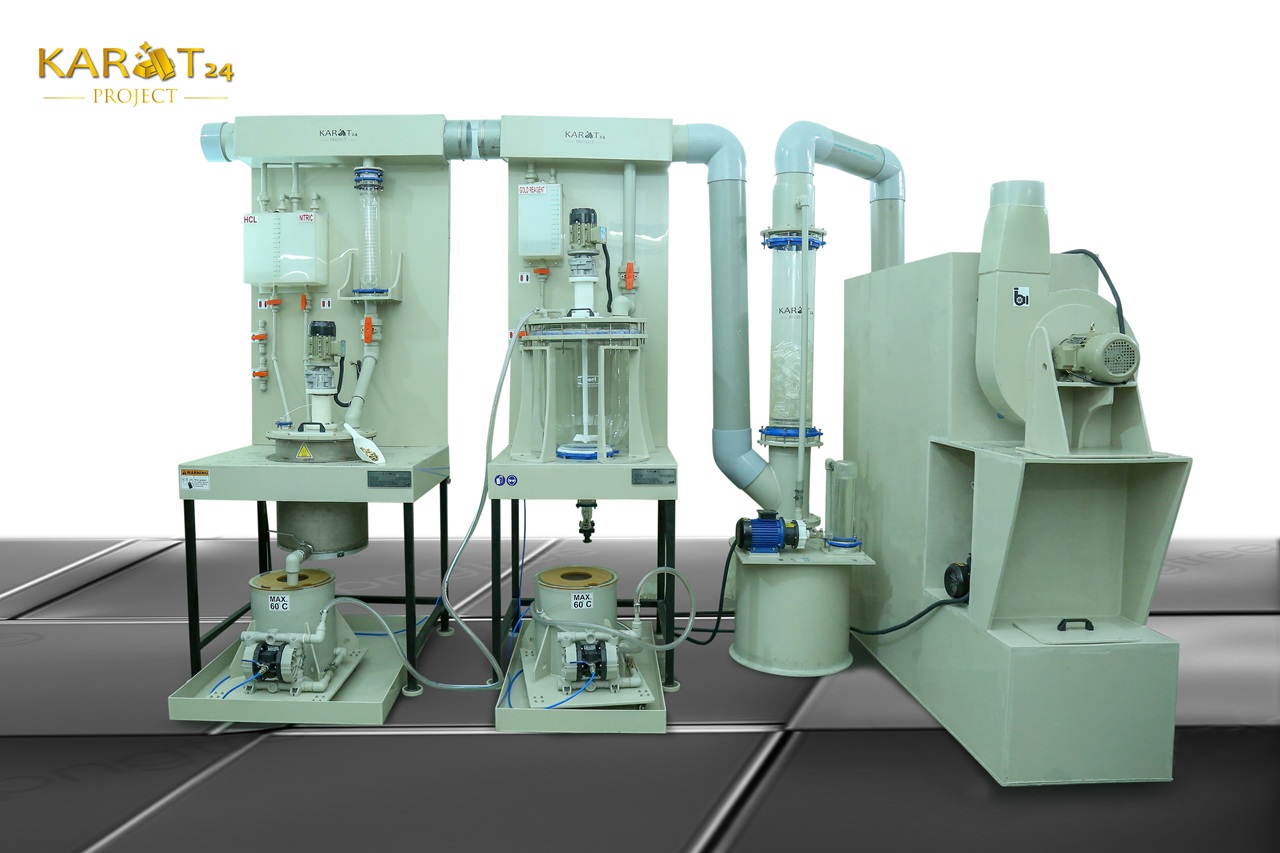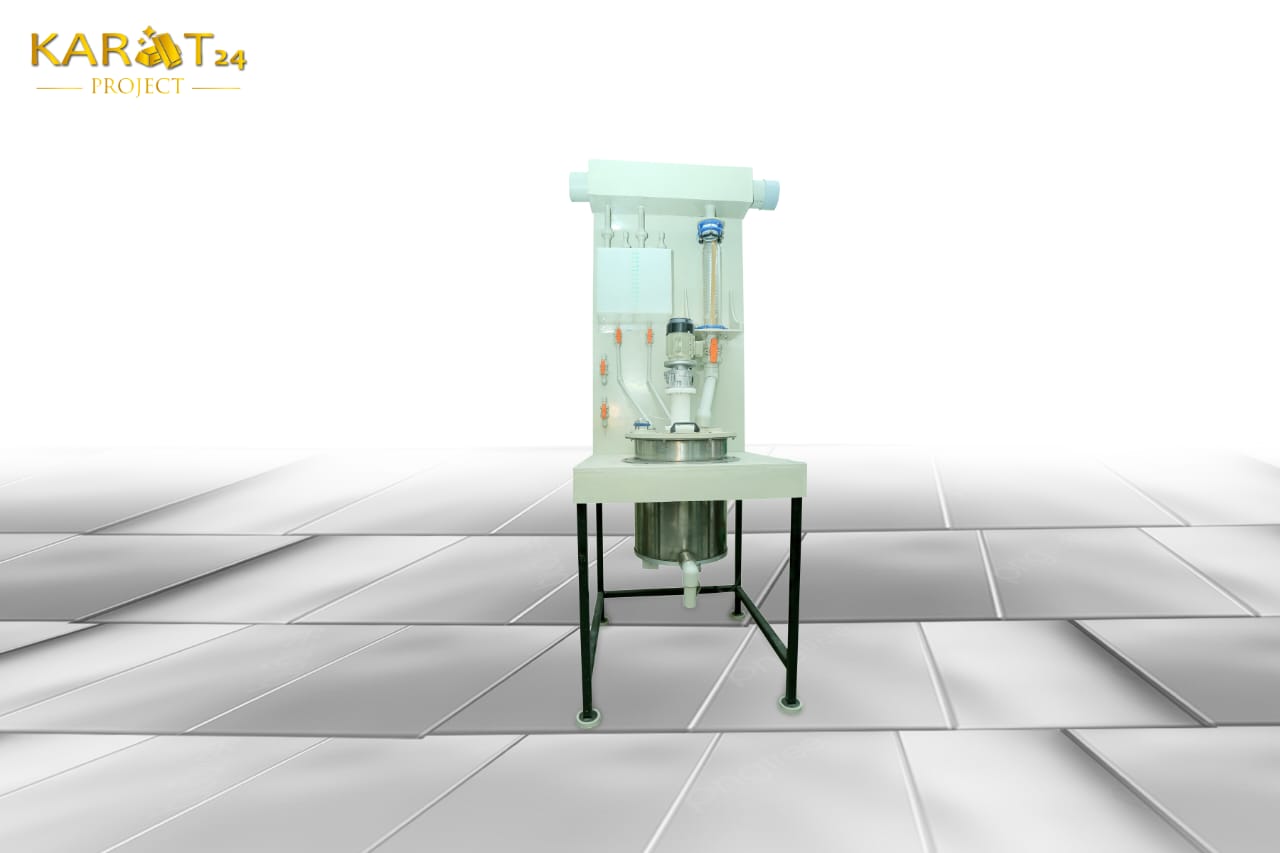Automatic Gold Refining Machine
In the ever-evolving precious metals industry, where precision, efficiency, safety, and purity are critical, our Automatic Gold Refining Machine stands at the forefront of innovation.
Developed through cutting-edge technology and advanced engineering, this state-of-the-art refining system delivers unmatched reliability, precision, and scalability.
It is designed to meet the rigorous demands of goldsmiths, refining operations, and large-scale precious metal processors, offering a comprehensive and streamlined solution for refining gold to the highest industry standards.
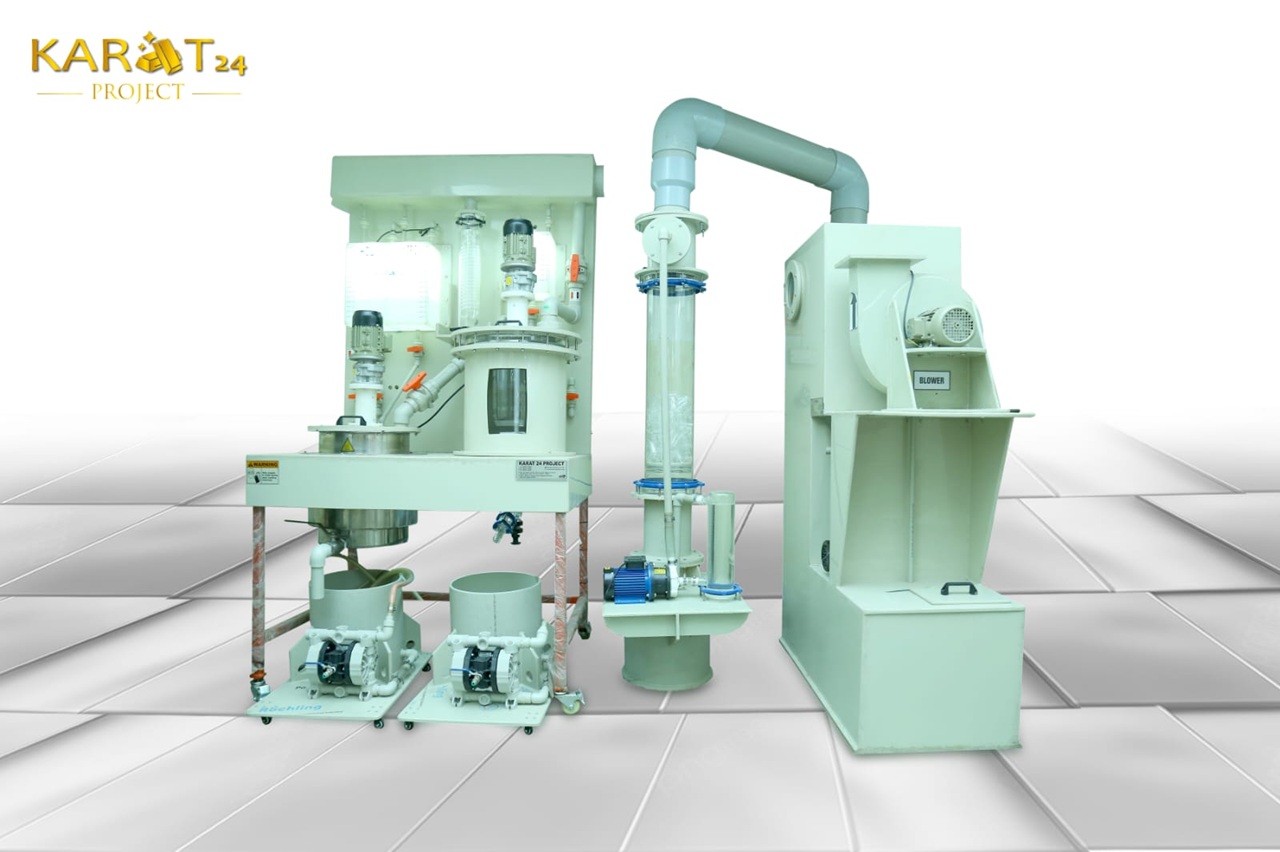
Key Features and Benefits:
Fully Automated Refining Process: Our machine automates each crucial step of the gold refining procedure, dramatically reducing the need for manual labor. This ensures uniformity, accuracy, and consistent output, allowing for more efficient operations while minimizing human error.
Unmatched Gold Purity: Achieve superior gold purity levels ranging from 999.5 to 999.8−9/1000 (99.95% to 99.989%), meeting or exceeding the most stringent standards in the precious metals industry. The machine guarantees that each batch produced is of the highest quality, ideal for use in high-end jewelry, bullion, or minting.
Enhanced Safety and Reliability: Engineered with top-tier, durable materials, the machine is built to endure continuous operation. Equipped with advanced safety mechanisms, it ensures the protection of operators while reducing the risk of accidents. Its fail-safe features, including emergency shut-offs and leak detection, provide an added layer of safety.
Flexible Batch Capacity: Whether you’re a small-scale artisan or a large commercial operation, this machine offers variable batch charge capacities from 1 kg to 100 kg, accommodating the needs of diverse production scales. This flexibility helps optimize throughput and minimizes operational costs.
Efficient Working Cycle: Designed for high productivity, the machine can process up to three batches within a 24-hour period, significantly improving output and operational efficiency. The compact design and high-speed processing ensure you meet demanding production timelines without sacrificing quality.
Precise Process Control: The Automatic Gold Refining Machine incorporates sophisticated control systems for managing critical parameters such as temperature, chemical reactions, and other refining conditions. This ensures consistent, high-quality results across every batch.
Robust and Durable Construction: Built for the long haul, the machine is constructed using high-strength materials that withstand the wear and tear of continuous refining cycles. Its low maintenance requirements and long operational life minimize downtime and repair costs.
Electrical and Environmental Efficiency: Operating on a standard 3-phase electrical power supply, the machine integrates seamlessly with industrial power systems. It is designed with environmental sustainability in mind, minimizing waste and reducing chemical consumption, making it an eco-friendly choice for modern refining businesses.

Watch Video
Technical Specifications of Our Gold Refinery Machine:
Alloy Batch Charge: 1 kg to 100 kg
Working Cycle Time: Up to 3 batches per 24 hours
Purity Achievable: 999.5 to 999.8−9/1000 (99.95% to 99.989%)
Electric Power Supply: 3-Phase
Material Construction: High-grade stainless steel and corrosion-resistant alloys for maximum durability
Safety Features: Emergency stop, leak detection, and pressure regulation
Environmental Considerations: Low chemical consumption, minimized waste generation
Applications:
Gold Refining Businesses: Ideal for both small-scale and large-scale gold refining operations.
Jewelry Manufacturing: Perfect for jewelers who require high-purity gold for fine jewelry production.
Precious Metal Recycling Operations: Efficiently process scrap gold and other precious metals to recover pure gold.
Minting Facilities: Suitable for large-scale gold processing for minting coins, bars, or other bullion products.
The Automatic Gold Refining Machine is the ultimate solution for any business or facility looking to optimize its gold refining processes with an emphasis on purity, safety, and cost-efficiency. Its advanced technology and flexible design ensure it meets the evolving needs of the precious metals industry.
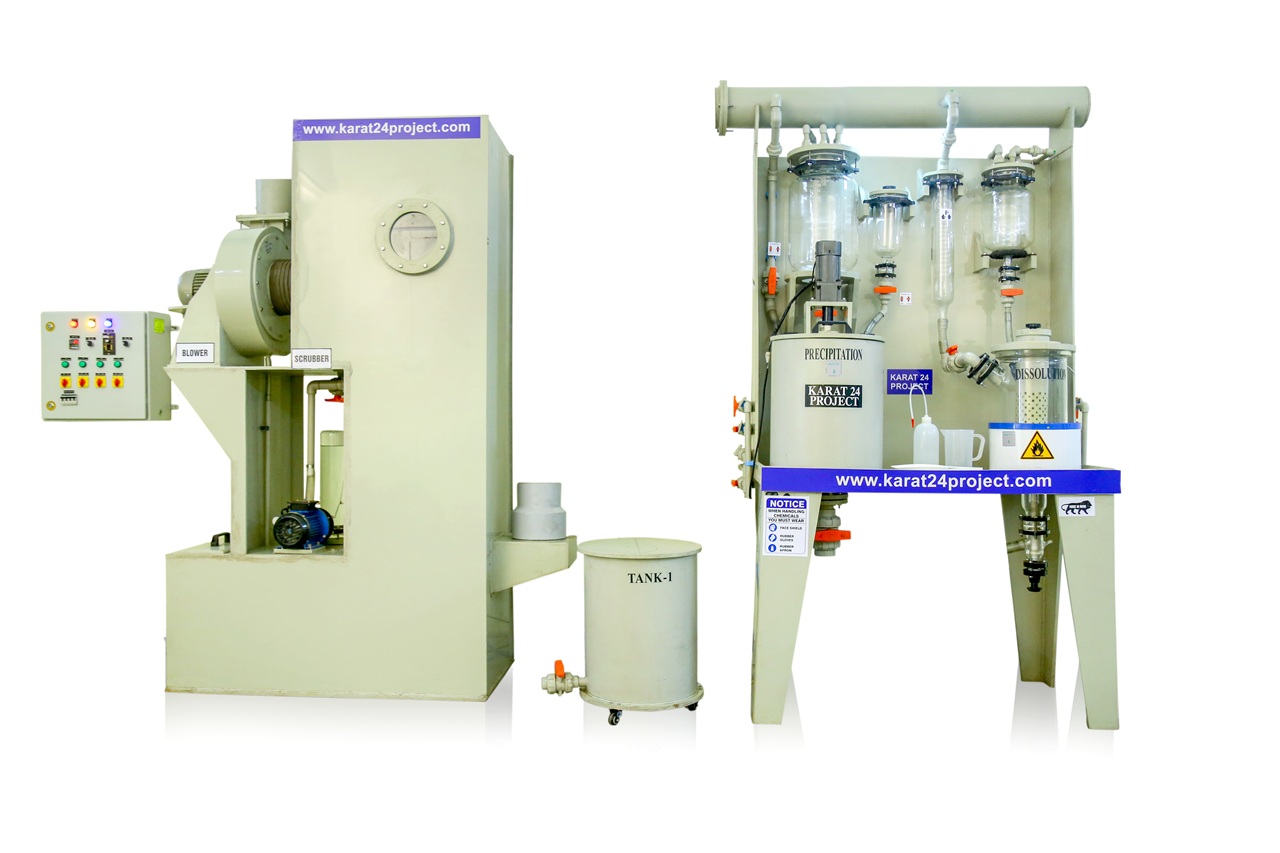
Watch Video
Machine Advantages:
Our Automatic Gold Refining Machine offers a comprehensive range of benefits that are specifically designed to enhance the efficiency, safety, and profitability of your gold refining operations. With cutting-edge technology and precision engineering, this machine is optimized to meet the demands of modern refining businesses. Here’s a closer look at the key advantages:
Space-Saving Compact Design:
The machine features a highly efficient, compact design that minimizes its physical footprint. This is especially beneficial for facilities with limited space or those operating within tight constraints. Its streamlined structure allows for easy installation and seamless integration into existing workflows, ensuring that no major changes to infrastructure are required. Whether you’re expanding your operations or optimizing your current setup, this space-efficient design maximizes your available space without sacrificing performance.
Intuitive and User-Friendly Operation:
Designed with ease of use in mind, the Automatic Gold Refining Machine boasts a simple and intuitive user interface. Operators can quickly get acquainted with its functions, dramatically reducing the learning curve. This ease of operation minimizes the likelihood of human error, ensuring consistent results with every batch. The interface allows for smooth control and monitoring of all critical parameters, making the refining process efficient and hassle-free.
Optimized Operational Efficiency and Cost Reduction:
The automated features of this machine streamline the refining process, dramatically reducing labor costs and human intervention. With fewer manual steps required, the machine helps reduce the risk of errors and improves overall operational efficiency. Additionally, the design is optimized for reduced chemical consumption and energy usage, leading to significant cost savings over time. Lower operating costs, combined with increased throughput, directly translate to enhanced profitability for your business.
Environmentally Conscious Fume-Free Operation:
One of the standout features of our Automatic Gold Refining Machine is its environmentally friendly design. It operates without producing harmful fumes, creating a safer and more pleasant working environment for your staff. This fume-free operation eliminates the need for costly and complex fume extraction systems, reducing both maintenance requirements and operational expenses. By promoting healthier working conditions, it also helps ensure compliance with environmental and safety regulations.
Maximized Gold Recovery with Zero Losses:
The machine’s advanced chemical processing and precise control systems are designed to maximize gold recovery while minimizing waste. Thanks to its highly optimized refining process, the system ensures that no gold is lost during refining, significantly improving yield and profitability. This zero-loss approach maximizes the value derived from each batch, making it an invaluable asset for businesses aiming to boost their gold recovery and overall efficiency.
Automated Acid Loading for Enhanced Safety and Consistency:
The integrated automated acid loading system is one of the key safety features of our machine. By eliminating the need for manual handling of highly corrosive chemicals, it reduces the risk of accidents and exposure to harmful substances. Additionally, the automatic acid loading ensures precise and consistent dosing, guaranteeing optimal chemical reactions for the best possible refining results. This increases the overall safety of your operations and improves the consistency of the refining process.
Minimal Maintenance Requirements for Uninterrupted Operation:
Built with robust, high-quality components, our machine is designed for longevity and reliability. Its low-maintenance nature ensures that your operation runs smoothly with minimal downtime. The durable construction minimizes the need for repairs or component replacements, allowing for uninterrupted production and increasing your return on investment. The machine is engineered to perform under continuous operation, reducing the risk of costly disruptions and keeping your workflow steady and efficient.
Enhanced Safety Through Automation:
Many steps in the refining process involve handling hazardous chemicals and high temperatures. With our Automatic Gold Refining Machine, numerous dangerous and labor-intensive steps are automated, significantly improving overall safety. The automation of these processes minimizes human exposure to potential risks, such as chemical burns or fumes, while also reducing the chances of accidents. The built-in safety features, such as automatic shutdowns and pressure regulation, ensure that the machine operates in the safest possible manner, protecting both operators and the environment.
Gold Refining Using the Aqua Regia Process
The Aqua Regia process is a time-honored, highly effective method for refining gold, utilizing the powerful oxidizing capabilities of a mixture of nitric acid (HNO₃) and hydrochloric acid (HCl). This process is renowned for its ability to refine gold to exceptional purity levels, making it particularly suitable for separating gold from alloys that contain significant amounts of gold. Aqua Regia is able to dissolve even the most inert metals, like gold, due to the unique chemical properties of its acid mixture.
The process has been a staple in precious metal refining for centuries and remains a cornerstone of high-purity gold production. To ensure maximum efficiency and success when using this method, there are several key considerations to be aware of during the refining process.
Key Considerations for Optimal Refining:
Initial Gold Purity: For optimal performance of the Aqua Regia process, the feedstock should contain a minimum initial gold purity of at least 600/1000 (60%). Feedstocks with lower gold content will require longer processing times, which can lower overall production capacity. Additionally, these feedstocks are likely to introduce more impurities that must be processed, further complicating the refining process. Starting with higher-purity feedstock ensures more efficient gold recovery and reduces the need for extended processing.
Silver Content Management:
The ideal maximum silver content in the feedstock should be no more than 10–12%. When the silver content exceeds this threshold, the dissolution process is hindered by the formation of insoluble silver chloride (AgCl). This byproduct can accumulate, causing delays in the dissolution process and complicating subsequent filtration steps. If the silver content is too high, it can also extend processing times, reduce production capacity, and potentially lower the purity of the final gold output. Therefore, careful management of silver content is crucial for achieving a successful refining process.
Feedstock Preparation: Grains vs. Strips:
Strips: Thin strips of gold alloy are considered ideal for Aqua Regia refining. Their flat shape and large surface area allow for rapid and complete dissolution when exposed to the acid mixture. This ensures efficient processing and minimizes the occurrence of undissolved residues. Strips provide the optimal feedstock format for achieving the best refining results.
Grains: Gold grains, produced by melting and granulating gold alloys, are a quicker and simpler option for feedstock preparation compared to strips. However, their irregular shape and varying sizes can lead to uneven dissolution rates. This means that some particles may remain undissolved in the reactor, requiring additional processing to recover the lost gold. To mitigate this issue, it is essential that the grains used in the process are uniform in size. Uniformly small grains promote more even dissolution and reduce the chance of leftover gold residues.
Process Chemistry: The chemistry behind the Aqua Regia process involves several critical reactions:
Initial Reaction:
HNO₃+3HCl→NOCl+2Cl+2H₂O
Nitric acid reacts with hydrochloric acid to produce chlorine gas, which is essential for dissolving gold.
Gold Dissolution:
Au+3Cl→AuCl₃
Gold reacts with chlorine to form gold chloride (AuCl₃).
Formation of Tetrachloroauric Acid:
AuCl₃+HCl→HAuCl₄
The gold chloride combines with additional hydrochloric acid to form tetrachloroauric acid (HAuCl₄), which is the soluble form of gold in the Aqua Regia solution.
The resulting tetrachloroauric acid (HAuCl₄) is then further processed to precipitate the pure gold. This solution undergoes additional steps, including reduction or precipitation, to separate the gold from the acid solution.
Process Considerations:
Ventilation & Fume Extraction:
The Aqua Regia process generates toxic gases, including chlorine and nitrogen dioxide, which can pose serious health risks if inhaled. Therefore, it is crucial that the process is conducted in a well-ventilated area or, preferably, under a proper fume extraction system. This ensures that toxic fumes are safely removed from the workspace, maintaining a safe environment for operators.
Careful Monitoring:
Continuous monitoring of key parameters (temperature, acid concentrations, and gold content) is essential to achieve the best results. Proper control of these variables ensures efficient dissolution and high gold recovery rates. Automated monitoring systems can enhance precision and consistency, helping to optimize the refining process.
Waste Disposal:
Proper disposal of the waste byproducts from the Aqua Regia process is essential. The chemicals involved are highly corrosive and toxic, and the waste needs to be handled with care. A comprehensive waste management system should be in place to neutralize or treat the acidic residues before disposal, ensuring compliance with environmental regulations and minimizing potential harm to the environment.
The Aqua Regia process is a powerful and effective method for refining gold, capable of producing gold with high purity levels when executed correctly. By understanding and optimizing key factors such as feedstock purity, silver content, feedstock preparation, and process chemistry, businesses can maximize the efficiency and profitability of their gold refining operations. Additionally, proper safety protocols, such as fume extraction and waste disposal, are vital to ensure a safe and compliant refining environment.
With attention to detail and careful management, the Aqua Regia process remains one of the most trusted and effective methods for extracting pure gold from complex alloys.
Machine Working Details and Specifications
Our Automatic Gold Refining Machine is engineered to provide precise, efficient, and safe gold refining using the Aqua Regia process. Below are the key features and specifications that ensure optimal performance and reliability:
Anti-Acid Polypropylene Hood
- Designed to house all critical components, the high-grade polypropylene hood is corrosion-resistant and ensures a safe, contained working environment.
- Equipped with a built-in acid recovery system to minimize acid losses and reduce environmental impact, promoting both safety and cost efficiency.
Electric Heater with Digital Temperature Controls
- The electric immersion heater features digital temperature controls for precise and consistent regulation of the Aqua Regia solution temperature.
- Temperature accuracy ensures optimal conditions for gold dissolution and enhances overall refining efficiency.
3-Coil Fume Condenser
- A highly effective three-coil fume condenser efficiently cools and condenses acid vapors, minimizing emissions and safely recovering valuable acid.
- The system helps maintain a safe and controlled environment while promoting environmental sustainability.
Mobile Filter Unit with Italian-Made Diaphragm Pump
- The filter unit is equipped with a high-performance compressed air diaphragm pump (made in Italy) for reliable solution transfer.
- The unit is mounted on wheels for easy mobility, ensuring flexibility in your workflow.
- Efficient filtration ensures impurities are effectively removed from the solution.
Gold Precipitation Tank
- A dedicated precipitation tank designed specifically for the controlled precipitation of pure gold from the Aqua Regia solution.
- Material: Constructed from durable, corrosion-resistant materials such as Polypropylene or Stainless Steel, ensuring longevity and efficient processing.
Acid Dosing Device (ADD) Tanks for HCl and HNO₃
- Separate acid dosing tanks for hydrochloric acid (HCl) and nitric acid (HNO₃) allow for accurate, automated acid dosing, ensuring correct proportions during the refining process.
- The Italian-made compressed air diaphragm pump facilitates precise acid transfer from the reactor, enhancing process consistency and safety.
PPH (Polypropylene Homopolymer) Storage Tray
- A durable polypropylene homopolymer (PPH) tray designed for the safe storage of chemicals and tools, providing a secure and organized space for auxiliary materials.
Compressed Air Diaphragm Pumps
- Multiple compressed air diaphragm pumps are strategically placed throughout the system to ensure smooth and efficient solution transfer at all stages of the refining process.
- These high-quality pumps are designed for reliability and consistent performance.
Electrical Control Panel
- The electric control panel provides a comprehensive interface for easy operation and monitoring of the entire refining process.
- Separate Miniature Circuit Breakers (MCBs) are provided for each motor to ensure enhanced safety and protection against electrical faults.
- Dual-drive system for the stirring motor allows precise control over stirring speeds for optimal solution mixing.
- Temperature control and RPM meter are integrated into the system, providing real-time monitoring and adjustments.
- Equipped with an emergency stop button for immediate shutdown in case of an emergency, ensuring operator safety.
- The control panel is compatible with country-specific power supplies, ensuring broad compatibility across different regions.
Stirring Motor and System
- The stirring motor features variable-speed control to allow precise agitation of the Aqua Regia solution, promoting efficient gold dissolution.
- Dual-drive system ensures consistent mixing, while the stirrer is made from Teflon-coated stainless steel to withstand the corrosive environment.
Specifications:
- Power Supply: [Specify Voltage and Frequency, e.g., 400V, 50Hz, 3-phase] for compatibility with industrial power systems.
- Compressed Air Supply: [Specify Pressure and Flow Rate, e.g., 6 bar, 100 liters/minute], ensuring consistent and efficient operation of diaphragm pumps.
This detailed specification highlights the advanced design and safety features of the Automatic Gold Refining Machine, providing you with a high-performance system capable of refining gold to exceptional purity levels.
Gold Refining Equipment’s
Dissolution Reactor
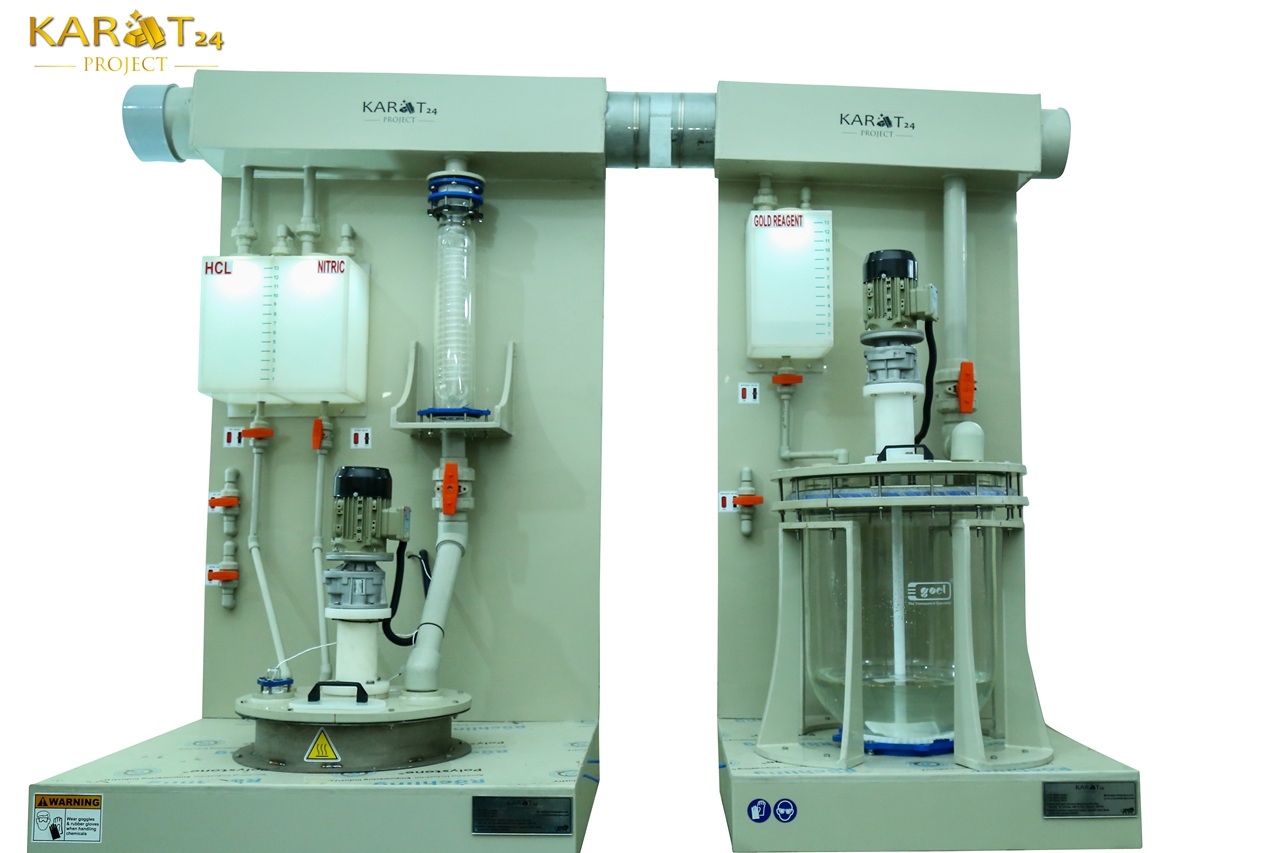
Key Features:
-
50L Cylindrical Borosilicate Glass Reactor:
Designed with high-quality borosilicate glass, this 50L reactor offers optimal durability and resistance to thermal and chemical stress. It provides an efficient and reliable solution for various dissolution processes. Additionally, the reactor is equipped with a discharge valve for seamless material handling and discharge. -
PTFE Turbine Stirrer with 0.5 HP Geared Motor:
The robust PTFE (Polytetrafluoroethylene) turbine stirrer ensures smooth and uniform mixing, even with viscous or corrosive liquids. Powered by a 0.5 HP geared motor, it delivers consistent and controlled agitation, enhancing dissolution efficiency. -
Electrically Heated Fiberglass-Insulated Mantle with RTD Temperature Control:
The reactor features an advanced, electrically heated fiberglass-insulated mantle that ensures uniform and precise heating. The RTD (Resistance Temperature Detector) control system allows for accurate temperature monitoring and regulation, ensuring optimal thermal conditions for the dissolution process. -
3-Coil Glass Condenser for Gold Chloride Fume Recovery:
Designed specifically for fume recovery, the 3-coil glass condenser efficiently captures and condenses harmful vapors, such as gold chloride fumes. This ensures a safe working environment while reducing harmful emissions. -
Dual AOD Pump Acid Charging System:
The reactor includes two high-performance AOD pumps (Italian-made), providing reliable and precise acid charging for controlled dissolution reactions. The system is equipped with durable PP (polypropylene) piping and glass bottles, ensuring compatibility with aggressive chemicals. -
Premium Material Construction:
The reactor is constructed with PTFE gaskets, stainless steel (SS) fasteners, and coated flanges/fittings, offering superior resistance to chemical corrosion, high pressure, and thermal stress. These materials contribute to the long-term reliability and performance of the system.
This Glass Dissolution Reactor is engineered to provide optimal safety, performance, and durability in a wide range of chemical and industrial applications, making it an indispensable tool for laboratories and processing plants.
Filtration Unit
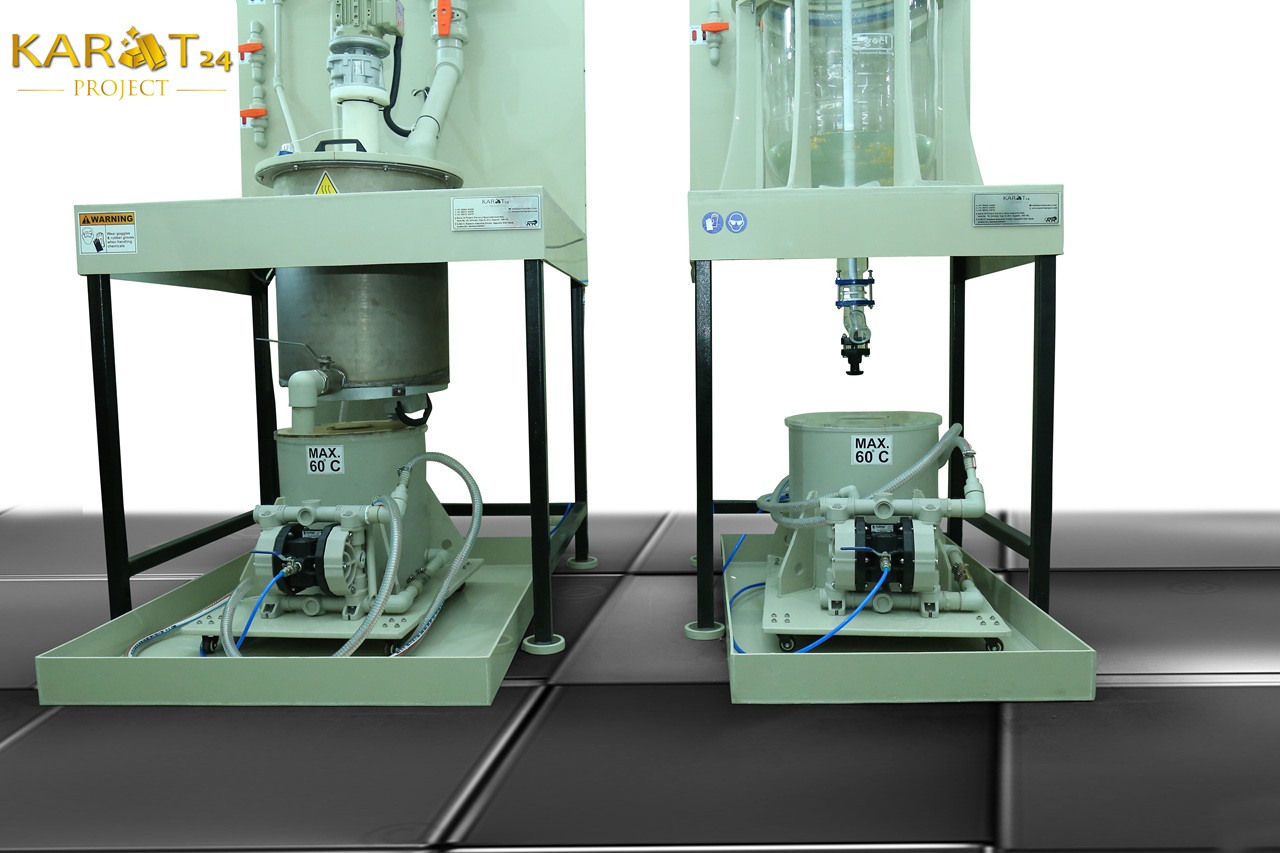
Key Features:
-
Spherical Polypropylene (PP) Filter Housing for Selective Metal Removal:
The filtration unit is equipped with a spherical polypropylene filter housing, specifically designed for the efficient removal of silver and other metals from solution, while allowing only gold to pass through. This robust housing offers excellent resistance to corrosion, ensuring durability in harsh chemical environments. The unique spherical design enhances filtration capacity and flow distribution, ensuring optimal filtration performance. -
Air-Operated Double Diaphragm (AOD) Pump (Italian):
Powered by a high-performance, air-operated double diaphragm (AOD) pump, made in Italy, this unit provides smooth, consistent flow and pressure during the filtration process. Known for its efficiency and reliability, the pump ensures efficient separation of metal impurities and smooth operation without the need for electricity. -
Selective Removal of Silver and Other Metals:
The filtration system is specifically designed to target and remove silver, copper, and other metallic impurities, leaving only the gold solution to pass through. This selective filtration process is ideal for refining gold solutions, ensuring purity and quality while minimizing waste and the need for further processing. -
Mobile Design for Easy Relocation:
The filtration unit features a mobile design for easy relocation within your laboratory or processing area. Equipped with durable casters, the unit offers convenient mobility for maintenance, space optimization, or relocation as needed, without compromising stability or performance during operation. -
Transparent Acrylic Safety Cover with Scrubber Connection Nozzle:
Fitted with a transparent acrylic safety cover, the filtration unit provides clear visibility of the filtration process. The cover ensures the safe containment of fumes and aerosols, while the integrated scrubber connection nozzle allows for easy integration with a fume scrubber system, enhancing safety by filtering out harmful vapors generated during filtration. -
Integrated Polypropylene (PP) Safety Tray:
An integrated polypropylene safety tray is included to catch any potential spills or leaks during the filtration process. Made from durable PP, the tray is resistant to chemical corrosion and helps maintain a clean workspace, reducing the risk of contamination and ensuring a safer working environment.
This Filtration Unit is engineered to deliver reliable, efficient, and safe metal removal in gold refining and other industrial applications. Its advanced design features make it an indispensable tool for improving purity, minimizing downtime, and ensuring optimal filtration performance while maintaining a secure working environment.
Precipitation Reactor
Key Features:
-
100L Cylindrical Borosilicate Glass Reactor with Discharge Valve:
This robust 100L cylindrical reactor is crafted from high-quality borosilicate glass, offering superior thermal and chemical resistance for demanding precipitation processes. The reactor’s large capacity is ideal for handling significant volumes of solution, while the discharge valve ensures smooth, controlled removal of the contents with minimal risk of contamination or loss. -
PTFE Turbine Stirrer with 0.5 HP Geared Motor:
The reactor is equipped with a high-performance PTFE (Polytetrafluoroethylene) turbine stirrer, ensuring uniform and efficient agitation of the solution. Powered by a 0.5 HP geared motor, the stirrer provides consistent mixing, even for viscous or corrosive solutions, promoting complete and effective precipitation reactions. -
Single AOD Pump (Italian) Reagent Charging System with PP Piping and Bottles:
Featuring an Italian-made air-operated double diaphragm (AOD) pump, this system delivers precise and controlled reagent charging for the precipitation process. The pump is designed for durability and reliability, ensuring efficient reagent delivery. The system includes polypropylene (PP) piping and bottles, offering compatibility with aggressive chemicals and ensuring a long service life under harsh conditions. -
Sealed Acrylic Safety Bath:
The reactor is housed in a sealed acrylic safety bath that provides additional protection during the precipitation process. The transparent acrylic design allows for clear visibility of the reaction while ensuring containment of any potential spills, fumes, or vapors. The bath also helps maintain a stable temperature and protects the surrounding environment from chemical exposure. -
Scrubber Connection Nozzle for Fume-Free Operation:
For enhanced safety, the precipitation reactor features an integrated scrubber connection nozzle, allowing for the efficient removal of any hazardous fumes generated during the process. This ensures a fume-free operation and helps maintain a safe and clean working environment, preventing harmful emissions from escaping into the air.
The Precipitation Reactor is specifically engineered for the efficient, safe, and reliable precipitation of metals and other substances in industrial and laboratory applications. Its advanced design features ensure that the process is not only effective but also environmentally responsible, providing optimal performance while protecting both operators and the surrounding environment.
Three-Stage Fume Scrubber
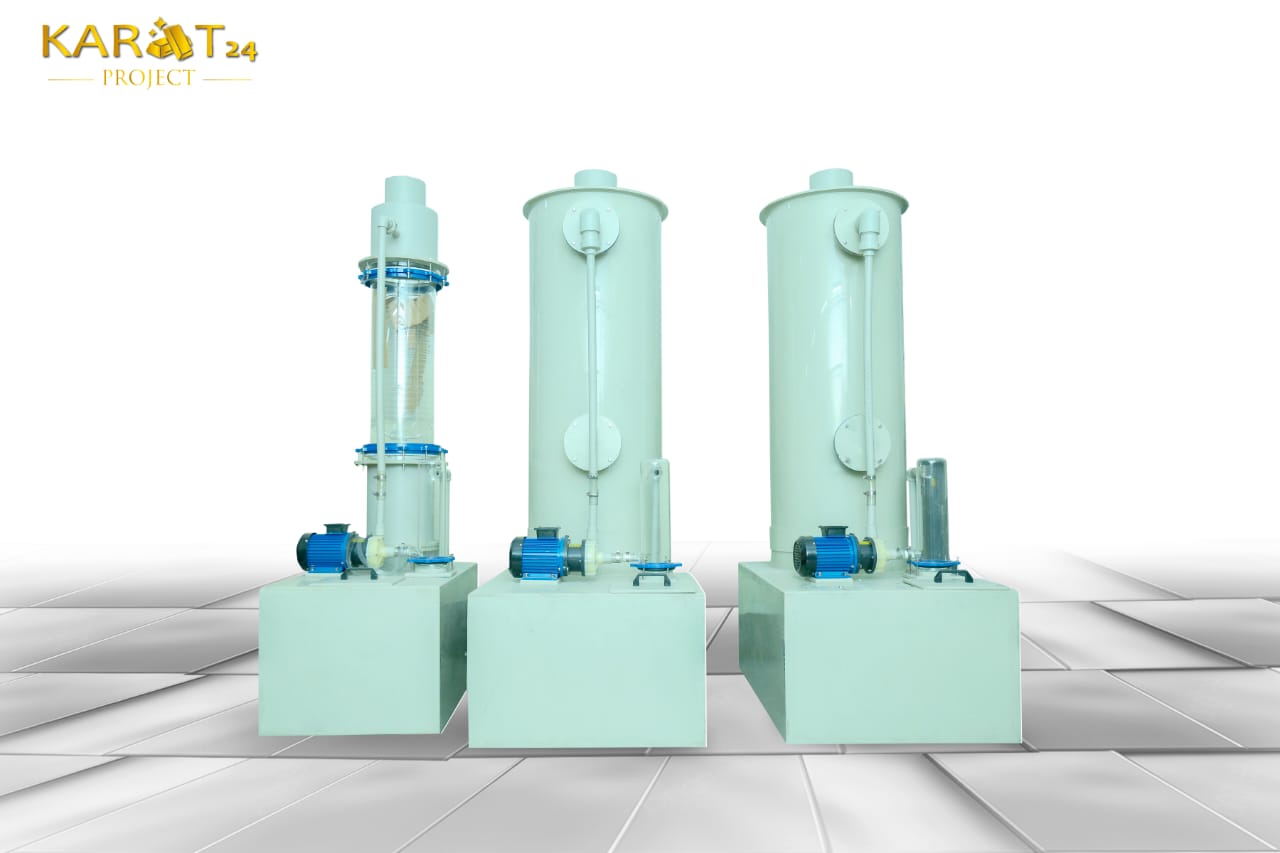
Key Features:
-
Three-Stage Filtration Design:
The scrubber features a comprehensive three-stage filtration system that ensures optimal air quality and effective removal of hazardous fumes. The stages include a pre-wash, polypropylene (PP) scrubber, and a final carbon filter, each designed to address different types of fumes and provide maximum protection for both the environment and operators. -
Pre-Wash Stage with PP Tank, Pump, and Glass NRV for Acid Fume Neutralization:
The first stage of the system is a pre-wash designed to neutralize acid fumes. It includes a high-quality polypropylene (PP) tank and pump for efficient liquid flow, along with a glass non-return valve (NRV) that ensures safe and reliable operation by preventing backflow. This stage helps neutralize corrosive vapors, protecting downstream components and reducing wear on the system. -
Polypropylene (PP) Scrubber for Residual Acid Fume Removal:
The second stage is a highly durable PP scrubber, specifically designed to remove residual acid fumes from the airflow. The PP material provides exceptional resistance to corrosion, ensuring long-term performance even in harsh chemical environments. The scrubber efficiently captures any remaining acid particles, preventing them from escaping into the atmosphere. -
External Charging Nozzle and Dual Damper Valves for Easy Maintenance:
The scrubber is equipped with an external charging nozzle, allowing for convenient addition of chemicals or reagents for neutralization or cleaning. Dual damper valves are integrated into the system, enabling easy maintenance and providing flexibility to control airflow and pressure during servicing, ensuring minimal downtime and maximizing operational efficiency. -
Central Glass Viewport for Monitoring:
A central glass viewport allows operators to visually monitor the scrubber’s operation and the status of the filtration process. This transparent feature ensures that the system is functioning properly and provides immediate visual feedback for detecting any issues, enhancing safety and enabling quick intervention if necessary. -
2000 CFM Blower with PP Cover:
The system is powered by a high-efficiency 2000 CFM blower, providing strong airflow to move fumes through the filtration stages. The blower is housed in a durable PP cover, ensuring resistance to corrosion and other chemical damage while maintaining stable and consistent air movement for optimal performance. -
Carbon Air Filter for Final Air Purification:
The final stage of filtration utilizes a carbon air filter to remove any remaining organic compounds, odors, or residual fumes. The carbon filter provides superior air purification, ensuring that the air leaving the system is clean, odor-free, and compliant with environmental and safety standards.
The Three-Stage Fume Scrubber is an advanced, highly efficient system designed to safely and effectively neutralize, scrub, and purify air in environments where hazardous fumes are generated. Its durable construction, easy maintenance features, and comprehensive filtration stages make it an essential tool for laboratories, industrial facilities, and chemical processing plants where fume control and air quality are critical.
Dual Electrical Control Panels
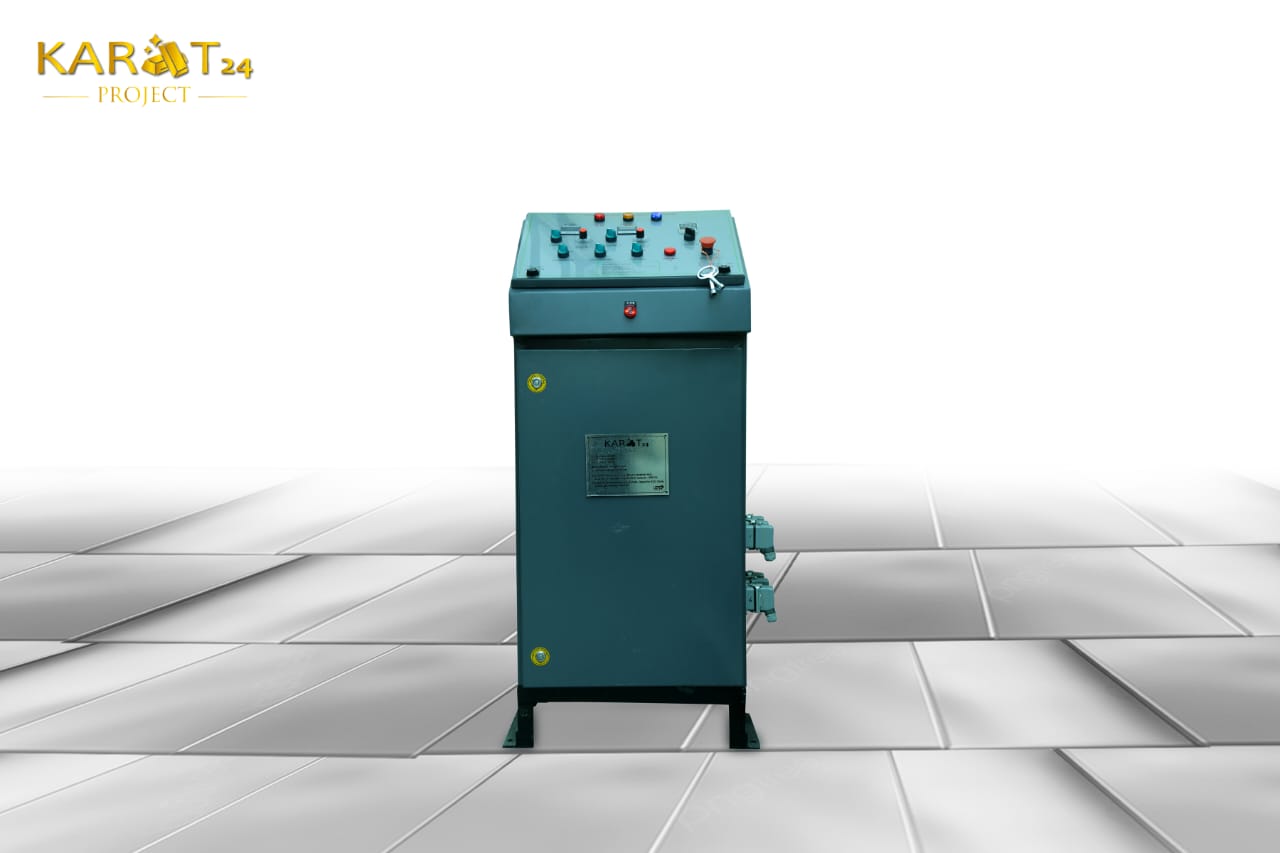
Key Features:
-
Separate Operating and Control Panels:
The system features two distinct electrical panels: one dedicated to operating the equipment and the other focused on controlling and monitoring functions. This separation enhances usability, allowing for more intuitive operation and streamlined management of system functions. It ensures users can quickly access and adjust controls as needed without confusion. -
Individual MCB (Miniature Circuit Breaker) Protection for Each Motor:
For optimal safety and system protection, each motor is equipped with its own MCB. This helps prevent overcurrent or short-circuiting. In the event of an electrical fault, only the affected motor will be isolated, allowing the rest of the system to continue operating normally without interruption. -
Dual Variable Frequency Drives (VFDs) for Stirring Motor Control:
The dual Variable Frequency Drives (VFDs) provide precise and independent control over the stirring motors. With VFDs, users can adjust motor speeds to optimize performance and energy efficiency, offering enhanced flexibility in operation. These drives allow for smooth, continuous stirring adjustments, improving overall consistency and control of the system. -
Integrated Temperature Control with RPM Meter:
An advanced integrated system combines temperature regulation with a real-time RPM meter. The temperature control mechanism ensures that the process is maintained within the desired thermal range, while the RPM meter provides continuous feedback on motor speed. This allows operators to monitor and fine-tune both parameters simultaneously for improved process accuracy and stability. -
Emergency Stop Button:
The inclusion of an emergency stop button ensures immediate shutdown in case of any unforeseen issues or safety concerns, providing an added layer of security. This feature quickly disengages all power to the system, allowing operators to have full control in emergency situations and preventing further damage or hazards. -
Country-Specific Power Supply Configuration:
The dual electrical control panels are designed with country-specific power supply configurations, ensuring compatibility with local electrical standards and regulations. This feature ensures seamless integration into various international settings without the need for additional adapters or modifications, providing hassle-free installation and compliance with local codes. -
Socket-Type Motor and Pump Connections for Easy Setup:
To facilitate quick and simple setup, the system utilizes socket-type motor and pump connections. This design feature eliminates the need for complex wiring during installation, reducing setup time and making it easy to replace or maintain components. Users can easily connect and disconnect motors and pumps, ensuring minimal downtime and efficient serviceability.
The Dual Electrical Control Panels are engineered to offer reliable, safe, and efficient operation for complex systems. With advanced features such as precise motor control, integrated temperature and speed monitoring, and enhanced safety mechanisms, these control panels ensure optimal performance and ease of use for operators in both laboratory and industrial environments.




